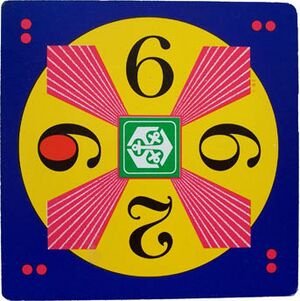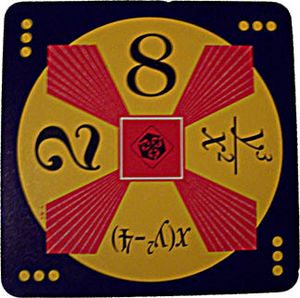24 Game facts for kids
The 24 Game is a fun card game where you use math to reach the number 24. You get four numbers and must combine them using addition, subtraction, multiplication, or division. The goal is to make the final answer exactly 24. For example, if you have the numbers 4, 7, 8, and 8, one way to get 24 is: (7 - (8 ÷ 8)) × 4 = 24.
This game has been played in Shanghai since the 1960s. People used regular playing cards. It's also been called Maths24. However, these older versions are different from the official, copyrighted 24® Game.
Playing the Original 24 Game
The first version of the 24 Game uses a standard deck of playing cards. You remove all the face cards (Jacks, Queens, Kings). Aces count as the number 1.
How to Play
Four cards are dealt to the table. The first player who can make the number 24 wins that round. You can only use addition, subtraction, multiplication, and division. You can also use parentheses to group numbers. Some advanced players might use more complex math like powers or roots.
Winning the Game
In short games, the player who solves a hand gets to keep the cards. If no one can find a solution, the cards are put back into the deck. The game ends when all cards from the deck are used. The player with the most cards wins.
A slightly different version includes the Jack, Queen, and King. They are given values of 11, 12, and 13.
The Official 24® Game
The 24® Game is a special card game for students. It's mostly played by kids in primary school and high school. While you can play it for fun, it was also used in big math tournaments. These tournaments happened in South Africa during the 1990s. The game was very popular then.
Engineer and inventor Robert Sun created and copyrighted the modern 24® Game in 1988. The first version, called Single Digits, came out in schools in 1989. Suntex International Inc. in Pennsylvania produces the game today. The goal was to make math fun and help students learn.
What the Cards Look Like
The cards are square, about 10 centimeters (4 inches) on each side. They are made of thin cardboard and are printed on both sides. Each card shows four numbers. These numbers are usually single digits from 1 to 9. Numbers can be repeated on a card. The cards are designed so you can read them from any direction.
The difficulty of a card is shown by dots in its corners.
- One white dot means it's easy.
- Two red dots mean it's medium difficulty.
- Three yellow dots mean it's hard.
How to Play the Official Game
The game has basic rules, but many small changes were also used. Usually, a few players (up to four) sit around a table. Cards are placed one at a time in the middle. The first person to put their hand on the card and say they have a solution gets to share their answer.
Playing in Tournaments
The 24® Game was often played in big tournaments. These events ranged from school contests to international competitions.
Players start at tables of four, with a judge at each table. The game is played in rounds, and players earn points.
- You get points for solving cards.
- Easier cards give 1 point, medium cards give 2 points, and hard cards give 3 points.
- If you claim a card but give a wrong answer, points are taken away.
Rounds last for a set amount of time. The players with the most points move on to the next level.
In top competitions, players would solve cards almost instantly. This is because there are a limited number of cards. Players might even remember solutions. Some players would quickly figure out the answer in the short time between claiming a card and saying the solution.
Different Ways to Play
Many variations of the game were made. This added more challenge to tournaments.
Changing the Target Number
Sometimes, the goal wasn't 24. Players might try to make 25, 36, or 48 using the same cards.
Time Trial Challenge
In this version, each player gets a whole pack of cards. They work through the pack alone, solving all the cards. Their time is recorded and compared to others. The fastest player wins.
Fractions Edition
New cards were made that included fractions. This added a new level of difficulty to the game.
Algebra and Exponents Edition
Later cards included x and y variables. These could appear as fractions or with powers. Players had to find numbers less than ten that the variables could be. Then they had to solve the card.
30th Anniversary
In 2018, the 24® Game celebrated 30 years. It continues to help kids improve their math skills. These include calculating, solving problems, understanding numbers, and thinking critically.
Strategy for the Game
To play well, you need to be good at mental math and think fast. You are not allowed to use paper and pencil in tournaments.
Some math operations can make more solutions possible. For example, if you have four 1s (1, 1, 1, 1), you can't make 24 with just basic math. But if you use a factorial, you can: (1 + 1 + 1 + 1)! = 24.
See also
In Spanish: 24 (juego de cartas) para niños



